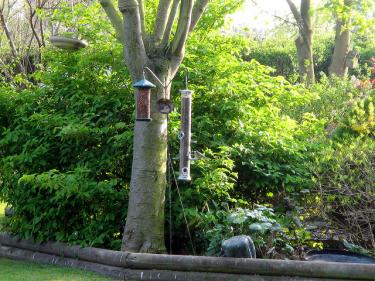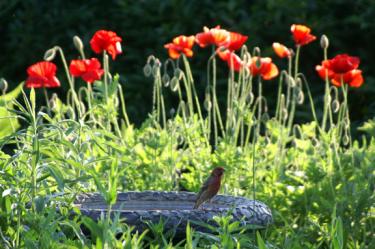Attracting Birds with Feeders
Restoring multi-story health to your woods takes time. While your forest canopy is developing, you may want to supplement bird resources with a feeding station. Placing feeders near your home is a good way to see birds up close, which is helpful when you are just beginning to learn bird identification.
Feeders are especially valuable to birds in winter, when food is scarce; but birds will also look for supplemental feeding in spring, summer and fall during nesting and migrations. Regardless of season, make sure your feeding area provides the following:
1. Reliable food
There are a variety of feeders and feeds available, some of which are specific to certain bird species. Feeders mimic the feeding styles of different birds in the forest, so some feeders are meant to be placed close to the ground for birds like towhees and sparrows, while some are designed for birds like chickadees and cardinals that feed at shrub or tree height. You may also want to get a feeder designed specifically for hummingbirds, which can help these tiny birds fatten up for their long fall migrations. If you want to attract a diverse group of birds, get several different types of feeders and place them at different levels. Consider switching your food in the winter to high calorie, high fat foods like oil sunflower, suet or peanuts.
2. A fresh water source
Have plenty of water available in a birdbath, fountain or pond, and make sure to keep small water sources clean to prevent the spread of avian diseases.
3. Cover
Make sure that there is ample cover for birds near feeders, so if predators arrive they can find safety quickly. The best option is to plant native plants, some of which provide both food and cover. Each region has native bird "super-plants"; for example, the highbush blueberry, a shrub native to the northeastern part of the United States, attracts 30 species of birds! Find out what works best in your region. An evergreen tree or shrub can provide cover year round.
Find out more
- Click here for more info on choosing a feeder that's right for you.
- You can make your own bird seed combinations and recipes. Check out these seed descriptions and recipes from the National Audubon Society.
How can I get more tips?
It’s simple! Enter your email below.


